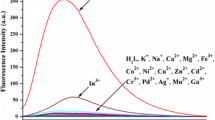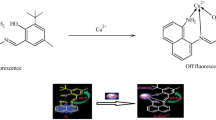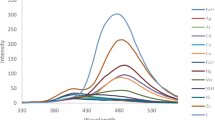Abstract
In this study, a new phenolphthalein derivative, FFIZNA, has been planned and successfully prepared in an uncomplicated way. The probe FFIZNA could selectively monitor Al3+ and Zn2+ among other relevant cations with diverse colors through a turn-on emission response in EtOH:HEPES (9/1;v/v) media owing to the chelation enhanced fluorescence (CHEF), prevention of ESIPT, -C=N- isomerization and PET of the probe FFIZNA. The interactions of Al3+ and Zn2+ with the probe FFIZNA were confirmed by emission spectroscopy, Job’s plot and 1H-NMR titration substantiated 1:2 reaction stoichiometry between FFIZNA and Al3+ and Zn2+. The time-response study displayed that the emission of FFIZNA with Al3+ and Zn2+, rapidly boosted and reached the stable value in less than 3.0 and 4.0 min, respectively. Therefore, the FFIZNA has successfully been utilized to the dual recognition of Al3+ and Zn2+ in solutions.
Graphical abstract
Phenolphthalein conjugated schiff base as a dual emissive fluorogenic probe for the detection aluminum (III) and zinc (II) ions.









Similar content being viewed by others
References
Shi X, Wang H, Han T, Feng X, Tong B, Shi J, Zhi J, Dong Y (2012) A highly sensitive, single selective, real-time and “turn-on” fluorescent sensor for Al3+ detection in aqueous media. J Mater Chem 22:19296. https://doi.org/10.1039/c2jm33393g
Kim S, Noh JY, Kim KY, Kim JH, Kang HK, Nam SW, Kim SH, Park S, Kim C, Kim J (2012) Salicylimine-based fluorescent chemosensor for aluminum ions and application to bioimaging. Inorg Chem 51:3597–3602. https://doi.org/10.1021/ic2024583
Shyamal M, Mazumdar P, Maity S, Sahoo GP, Salgado-Morán G, Misra A (2016) Pyrene scaffold as real-time fluorescent turn-on Chemosensor for selective detection of trace-level Al(III) and its aggregation-induced emission enhancement. J Phys Chem A 120:210–220. https://doi.org/10.1021/acs.jpca.5b09107
Fu Y, Jiang X-J, Zhu Y-Y, Zhou BJ, Zang SQ, Tang MS, Zhang HY, Mak TCW (2014) A new fluorescent probe for Al 3+ based on rhodamine 6G and its application to bioimaging. Dalton Trans 43:12624–12632. https://doi.org/10.1039/C4DT01453G
Li Z, Zhao J-L, Wu Y-T, Mu L, Zeng X, Jin Z, Wei G, Xie N, Redshaw C (2017) Highly selective recognition of Al3+ and I− ions using a bi-functional fluorescent probe. Org Biomol Chem 15:8627–8633. https://doi.org/10.1039/C7OB02301D
Pan X, Jiang J, Li J, Wu W, Zhang J (2019) Theoretical design of near-infrared Al3+ fluorescent probes based on Salicylaldehyde Acylhydrazone Schiff Base derivatives. Inorg Chem 58:12618–12627. https://doi.org/10.1021/acs.inorgchem.9b01335
Sahoo SK, Sharma D, Bera RK, Crisponi G, Callan JF (2012) Iron(III) selective molecular and supramolecular fluorescent probes. Chem Soc Rev 41:7195–7227. https://doi.org/10.1039/c2cs35152h
Hwang GW, Jeon J, Neupane LN, Lee K (2018) Sensitive ratiometric detection of Al(III) ions in a 100% aqueous buffered solution using a fluorescent probe based on a peptide receptor. New J Chem 42:1437–1445. https://doi.org/10.1039/C7NJ04160H
Jiang P, Guo Z (2004) Fluorescent detection of zinc in biological systems: recent development on the design of chemosensors and biosensors. Coord Chem Rev 248:205–229. https://doi.org/10.1016/j.cct.2003.10.013
Tabakci B, Ahmed HMA, Erdemir S (2019) Fast and reversible “turn on” fluorescent sensors based on Bisphenol-a for Zn2+ in aqueous solution. J Fluoresc 29:1079–1087. https://doi.org/10.1007/s10895-019-02419-8
Yan R, Wang Z, Du Z et al (2018) A biomimetic fluorescent chemosensor for highly sensitive zinc(II) detection and its application for cell imaging. RSC Adv 8:33361–33367. https://doi.org/10.1039/C8RA06501B
Yao K, Fu J, Chang Y, Li B, Yang L, Xu K (2018) A selective fluorescent probe for relay detection of Zn2+ and tartrate: application to logic circuit and living cell imaging. Spectrochim Acta A Mol Biomol Spectrosc 205:410–418. https://doi.org/10.1016/j.saa.2018.07.051
Choi YW, Park GJ, Na YJ, Jo HY, Lee SA, You GR, Kim C (2014) A single schiff base molecule for recognizing multiple metal ions: a fluorescence sensor for Zn(II) and Al(III) and colorimetric sensor for Fe(II) and Fe(III). Sensors Actuators B Chem 194:343–352. https://doi.org/10.1016/j.snb.2013.12.114
Aydin D (2020) Sensing of aluminum and cyanide ions utilizing a novel bis-phenol a based fluorogenic probe: applications in test stripts. Microchem J 159:105477. https://doi.org/10.1016/j.microc.2020.105477
Boonkitpatarakul K, Wang J, Niamnont N, Liu B, Mcdonald L, Pang Y, Sukwattanasinitt M (2016) Novel turn-on fluorescent sensors with mega stokes shifts for dual detection of Al3+ and Zn2+. ACS Sensors 1:144–150. https://doi.org/10.1021/acssensors.5b00136
Qin J, Yang Z (2015) Ratiometric fluorescent probe for Al3+ based on coumarin derivative in aqueous media. Anal Methods 7:2036–2040. https://doi.org/10.1039/C4AY02971B
Yue X, Wang Z, Li C, Yang Z (2017) Naphthalene-derived Al3+ selective fluorescent chemosensor based on PET and ESIPT in aqueous solution. Tetrahedron Lett 58:4532–4537. https://doi.org/10.1016/j.tetlet.2017.10.044
Aich K, Goswami S, Das S, Das MC (2015) A new ICT and CHEF based visible light excitable fluorescent probe easily detects in vivo Zn2+. RSC Adv 5:31189–31194. https://doi.org/10.1039/C5RA03353E
Cui S, Tang Y, Lu R, Pu S (2016) A multi-addressable diarylethene for the selective detection of Al3+ and the construction of a logic circuit. RSC Adv 6:107475–107482. https://doi.org/10.1039/C6RA23295G
He L, Dong B, Liu Y, Lin W (2016) Fluorescent chemosensors manipulated by dual/triple interplaying sensing mechanisms. Chem Soc Rev 45:6449–6461. https://doi.org/10.1039/C6CS00413J
Aydin D (2020) A novel turn on fluorescent probe for the determination of Al3+ and Zn2+ ions and its cells applications. Talanta 210:120615. https://doi.org/10.1016/j.talanta.2019.120615
Xu Z, Mao X-J, Wang Y et al (2017) Rhodamine 6G hydrazone with coumarin unit: a novel single-molecule multianalyte (Cu2+ and Hg2+) sensor at different pH value. RSC Adv 7:42312–42319. https://doi.org/10.1039/C7RA05424F
Alici O, Aydin D (2021) A Schiff-base receptor based on phenolphthalein derivate appended 2-furoic hydrazide: highly sensitive fluorogenic “turn on” chemosensor for Al3+. J Photochem Photobiol A Chem 404:112876. https://doi.org/10.1016/j.jphotochem.2020.112876
Kutluca Alici M (2020) Phentroimidazole based fluorescence “turn on” sensor for highly sensitive detection of Zn2+ ions. J Fluoresc 30:269–273. https://doi.org/10.1007/s10895-020-02498-y
Lu Y, Huang S, Liu Y, He S, Zhao L, Zeng X (2011) Highly selective and sensitive fluorescent turn-on chemosensor for AI3+ based on a novel photoinduced electron transfer approach. Org Lett 13:5274–5277. https://doi.org/10.1021/ol202054v
Li Z, Liu C, Wang J, Wang S, Xiao L, Jing X (2019) Spectrochimica Acta part a: molecular and biomolecular spectroscopy a selective diaminomaleonitrile-based dual channel emissive probe for Al3+ and its application in living cell imaging. Spectrochim Acta A Mol Biomol Spectrosc 212:349–355. https://doi.org/10.1016/j.saa.2019.01.031
Kumar V, Kumar P, Kumar S, Singhal D, Gupta R (2019) Turn-on fluorescent sensors for the selective detection of Al3+ (and Ga3+) and PPi ions. Inorg Chem 58:10364–10376. https://doi.org/10.1021/acs.inorgchem.9b01550
Velmurugan K, Prabhu J, Raman A, Duraipandy N, Kiran MS, Easwaramoorthi S, Tang L, Nandhakumar R (2018) Dual functional fluorescent Chemosensor for discriminative detection of Ni2+ and Al3+ ions and its imaging in living cells. ACS Sustain Chem Eng 6:16532–16543. https://doi.org/10.1021/acssuschemeng.8b03625
Aydin D, Karakilic E, Karakurt S, Baran A (2020) Thiazolidine based fluorescent chemosensors for aluminum ions and their applications in biological imaging. Spectrochim Acta A Mol Biomol Spectrosc 238:118431. https://doi.org/10.1016/j.saa.2020.118431
Hu X, Li C, Song X, Zhang D, Li YS (2011) A new Cu2+-selective self-assembled fluorescent chemosensor based on thiacalix[4]arene. Inorg Chem Commun 14:1632–1635. https://doi.org/10.1016/j.inoche.2011.06.026
Acknowledgments
We thank the Research Foundation of KMU University for financial support of this work.
Author information
Authors and Affiliations
Contributions
Dr. Duygu AYDIN: (Supervision, investigation designed and directed the study, planned and carried out the experiments, wrote the manuscript). Dr. Meliha Kutluca Alici: (Supervision, designed and directed the study, contributed to the interpretation of the results and characterized of the molecules, carried out the experiments). The author(s) read and approved the final manuscript.
Corresponding author
Ethics declarations
Ethics Approval
For this type of study, the ethical approval was not required, because this study does not involve cell or animal manipulation.
Competing Interests
The authors declare that they have no conflict of interest.
Additional information
Publisher’s Note
Springer Nature remains neutral with regard to jurisdictional claims in published maps and institutional affiliations.
Highlights
• A novel dual emissive fluorescent probe FFIZNA was synthesized and characterized.
• The probe displayed selectivity towards Al3+ and Zn2+ ions in the presence of other metal ions in EtOH:H2O (9:1, v:v).
• The limits of detection of FFIZNA for sensing Al3+ and Zn2+ are down to 4.4 nM and 4.27 nM, respectively.
Supplementary Information
ESM 1
(DOCX 1.40 mb)
Rights and permissions
About this article
Cite this article
Aydin, D., Alici, M.K. Phenolphthalein Conjugated Schiff Base as a Dual Emissive Fluorogenic Probe for the Recognition Aluminum (III) and Zinc (II) Ions. J Fluoresc 31, 797–805 (2021). https://doi.org/10.1007/s10895-021-02704-5
Received:
Accepted:
Published:
Issue Date:
DOI: https://doi.org/10.1007/s10895-021-02704-5




